Novel Poly(ionic liquid) Augmented Membranes for Unconventional Aqueous Phase Applications in Fractionation of Dyes and Sugar
Abstract
1. Introduction
2. Materials and Methods
2.1. Materials
2.2. Instrumentations
2.3. Fabrication of the PIL Augmented Membranes
2.3.1. Synthesis of Poly(ionic) Liquid
2.3.2. PIL augmentation
2.4. Characterization
2.4.1. Water Contact Angle
2.4.2. FTIR
2.4.3. SEM
2.4.4. EDX
2.5. Performance
2.5.1. Filtrationof Dyes
2.5.2. Filtration of Sugars
3. Results
3.1. PIL Augmentation on Polyimide Membrane and Their Characterization
3.1.1. Synthesis of Poly(ionic) Liquid
3.1.2. Fabrication of Active Surface Layer
3.1.3. Fabrication of PIL Augmented Membrane
3.1.4. Measurement of Water Contact Angle
3.1.5. Zeta Potential Measurement
3.1.6. FTIR Analysis for Functionality Identification on Membrane Surface
3.1.7. Microscopic Imaging for Surface Morphology
3.1.8. EDX Analysis to Understand the Appearance/Relative Concentration of Heteroatom on Membrane Surface
3.2. Application
3.2.1. Separation of Dyes
3.2.2. Fractionation of Sugars
3.3. Stability of the PIL Membrane
4. Conclusions
Author Contributions
Funding
Institutional Review Board Statement
Informed Consent Statement
Data Availability Statement
Acknowledgments
Conflicts of Interest
References
- Brennecke, J.F.; Maginn, E. Ionic liquids: Innovative fluids for chemical processing. AIChE J. 2001, 47, 2384–2389. [Google Scholar] [CrossRef]
- Bonhôte, P.; Dias, A.-P.; Armand, M.; Papageorgiou, N.; Kalyanasundaram, K.; Grätzel, M. Hydrophobic, Highly Conductive Ambient-Temperature Molten Salts. Inorg. Chem. 1998, 37, 166. [Google Scholar] [CrossRef]
- Brennecke, J.F.; GurkanBurcu, E. Ionic Liquids for CO2 Capture and Emission Reduction. J. Phys. Chem. Lett. 2010, 1, 3459–3464. [Google Scholar] [CrossRef]
- Welton, T. Room-temperature ionic liquids. Solvents for synthesis and catalysis. Chem. Rev. 1999, 99, 2071–2084. [Google Scholar] [CrossRef]
- Zhao, H.; Xia, S.; Ma, P. Use of ionic liquids as ‘green’ solvents for extractions. J. Chem. Technol. Biotechnol. 2005, 80, 1089–1096. [Google Scholar] [CrossRef]
- Fortunato, R.; Afonso, C.A.M.; Reis, M.A.; Crespo, J.G. Supported liquid membranes using ionic liquids: Study of stability and transport mechanisms. J. Membr. Sci. 2004, 242, 197–209. [Google Scholar] [CrossRef]
- Dupont, J.; de Souza, R.F.; Suarez, P.A.Z. Ionic Liquid (Molten Salt) Phase Organometallic Catalysis. Chem. Rev. 2002, 102, 3667–3692. [Google Scholar] [CrossRef]
- Sheldon, R.A.; Lau, R.M.; Sorgedrager, M.J.; Van Rantwijk, F.; Seddon, K.R. Biocatalysis in ionic liquids. Green Chem. 2002, 4, 147–151. [Google Scholar] [CrossRef]
- Plechkova, N.V.; Seddon, K.R. Applications of ionic liquids in the chemical industry. Chem. Soc. Rev. 2008, 37, 123–150. [Google Scholar] [CrossRef] [PubMed]
- Holbrey, J.; Turner, M.B.; Rogers, R.D. Selection of Ionic Liquids for Green Chemical Applications. ACS Symp. Ser. 2003, 2–12. [Google Scholar] [CrossRef]
- Yuan, J.; Mecerreyes, D.; Antonietti, M. Poly(ionic liquid)s: An update. Prog. Polym. Sci. 2013, 38, 1009–1036. [Google Scholar] [CrossRef]
- Binnemans, K. Lanthanides and Actinides in Ionic Liquids. Compr. Inorg. Chem. II 2013, II, 641–673. [Google Scholar] [CrossRef]
- Binnemans, K. Ionic Liquid Crystals. Chem. Rev. 2005, 105, 4148–4204. [Google Scholar] [CrossRef]
- Huddleston, J.G.; Visser, A.E.; Reichert, W.; Willauer, H.D.; Broker, G.A.; Rogers, R.D. Characterization and comparison of hydrophilic and hydrophobic room temperature ionic liquids incorporating the imidazolium cation. Green Chem. 2001, 3, 156–164. [Google Scholar] [CrossRef]
- George, A.; Brandt, A.; Tran, K.; Zahari, S.M.N.S.; Klein-Marcuschamer, D.; Sun, N.; Sathitsuksanoh, N.; Shi, J.; Stavila, V.; Tran, K.; et al. Design of low-cost ionic liquids for lignocellulosic biomass pretreatment. Green Chem. 2015, 17, 1728–1734. [Google Scholar] [CrossRef]
- Schäfer, T.; Rodrigues, C.M.; Afonso, C.A.; Crespo, J.G. Selective recovery of solutes from ionic liquids by pervaporation—A novel approach for purification and green processing. Chem. Commun. 2001, 17, 1622. [Google Scholar] [CrossRef]
- Blanchard, L.A.; Brennecke, J.F. Recovery of organic products from ionic liquids using supercritical carbon dioxide. Ind. Eng. Chem. Res. 2001, 20, 287. [Google Scholar] [CrossRef]
- Takeuchi, H.; Takahashi, K.; Goto, W. Some observations on the stability of supported liquid membranes. J. Membr. Sci. 1987, 34, 19–31. [Google Scholar] [CrossRef]
- Kemperman, A.; Bargeman, D.; Boomgaard, T.V.D.; Strathmann, H. Stability of Supported Liquid Membranes: State of the Art. Sep. Sci. Technol. 1996, 31, 2733–2762. [Google Scholar] [CrossRef]
- Kamaz, M.; Vogler, R.; Jebur, M.; Sengupta, A.; Wickramasinghe, R. π Electron induced separation of organic compounds using supported ionic liquid membranes. Sep. Purif. Technol. 2020, 236, 116237. [Google Scholar] [CrossRef]
- Hernández-Fernández, F.; Rios, A.P.D.L.; Tomás-Alonso, F.; Palacios, J.; Villora, G. Preparation of supported ionic liquid membranes: Influence of the ionic liquid immobilization method on their operational stability. J. Membr. Sci. 2009, 341, 172–177. [Google Scholar] [CrossRef]
- Wang, J.; Luo, J.; Feng, S.; Li, H.; Wan, Y.; Zhang, X. Recent development of ionic liquid membranes. Green. Energy Environ. 2016, 1, 43–61. [Google Scholar] [CrossRef]
- Zhao, W.; He, G.; Nie, F.; Zhang, L.; Feng, H.; Liu, H. Membrane liquid loss mechanism of supported ionic liquid membrane for gas separation. J. Membr. Sci. 2012, 411, 73–80. [Google Scholar] [CrossRef]
- Quijano, G.; Couvert, A.; Amrane, A. Ionic Liquids: Applications and future trends in bioreactor technology. Bioresour. Technol. 2010, 101, 8923–8930. [Google Scholar] [CrossRef] [PubMed]
- Matsumoto, M.; Mochiduki, K.; Kondo, K. Toxicity of ionic liquids and organic solvents to lactic acid-producing bacteria. J. Biosci. Bioengin. 2004, 98, 344–347. [Google Scholar] [CrossRef]
- Kamaz, M.; Sengupta, A.; Gutierrez, A.; Chiao, Y.-H.; Wickramasinghe, R. Surface Modification of PVDF Membranes for Treating Produced Waters by Direct Contact Membrane Distillation. Int. J. Environ. Res. Public Health 2019, 16, 685. [Google Scholar] [CrossRef] [PubMed]
- Bacon, S.; Ross, R.; Daugulis, A.; Parent, J. Imidazolium-based Polyionic Liquid Absorbents for Bioproduct Recovery. Green Chem. 2017, 19, 5203–5213. [Google Scholar] [CrossRef]
- Shaplov, A.; D Ponkratov, Y.S.V. Poly (ionic liquid)s: Synthesis, Properties, and Application. Polym. Sci. Ser. 2016, 58, 73–142. [Google Scholar] [CrossRef]
- Yuan, J.; Schlaad, H.; Giordano, C.; Antonietti, M. Double hydrophilic diblock copolymers containing a poly(ionic liquid) segment: Controlled synthesis, solution property, and application as carbon precursor. Eur. Polym. J. 2011, 47, 772–781. [Google Scholar] [CrossRef]
- PrabhuCharan, K.T.; Pothanagandhi, N.; Vijayakrishna, K.; Sivaramakrishna, A.; Mecerreyes, D.; Sreedhar, B. Poly (ionic liquids) as ‘‘smart’’ stabilizers for metal nanoparticles. Eur. Polym. J. 2014, 60, 114–122. [Google Scholar] [CrossRef]
- Mori, H.; Ebina, Y.; Kambara, R.; Nakabayashi, K. Temperature-responsive self-assembly of star block copolymers with poly(ionic liquid) segments. Polym. J. 2012, 44, 550–560. [Google Scholar] [CrossRef]
- Zhanga, J.; Zhanga, S.; Hana, J.; Hub, Y.; Yana, R. Uniform acid poly ionic liquid-based large particle and its catalytic application in esterification reaction. Chem. Engin. J. 2015, 271, 269–275. [Google Scholar] [CrossRef]
- Guo, J.; Xu, Q.; Zheng, Z.; Zhou, S.; Mao, H.; Wang, B.; Yan, F. Intrinsically Antibacterial Poly (ionic liquid) Membranes: The Synergistic Effect of Anions. ACS Macro Lett. 2015, 4, 1094–1098. [Google Scholar] [CrossRef]
- Ethirajan, S.K.; Sengupta, A.; Jebur, M.; Kamaz, M.; Qian, X.; Wickramasinghe, R. Single-Step Synthesis of Novel Polyionic Liquids Having Antibacterial Activity and Showing π-Electron Mediated Selectivity in Separation of Aromatics. Chemistry 2018, 3, 4959–4968. [Google Scholar] [CrossRef]
- Tripathi, T.; Kamaz, M.; Wickramasinghe, S.R.; Sengupta, A. Designing Electric Field Responsive Ultrafiltration Membranes by Controlled Grafting of Poly (Ionic Liquid) Brush. Int. J. Environ. Res. Public Health 2019, 17, 271. [Google Scholar] [CrossRef] [PubMed]
- Gobara, M.; Saleh, A.; Naeem, I. Synthesis, characterization and application of acrylate-based poly ionic liquid for corrosion protection of C1020 steel In hydrochloric acid solution. Mater. Res. Express 2020, 7, 016517. [Google Scholar] [CrossRef]
- Kamaz, M.; Sengupta, A.; DePaz, S.; Wickramasinghe, S.R. Poly(ionic liquid) augmented membranes for π electron induced separation/fractionation of aromatics. J. Membr. Sci. 2019, 579, 102–110. [Google Scholar] [CrossRef]
- Zhang, C.; Ma, M.-Q.; Chen, T.-T.; Zhang, H.; Hu, D.-F.; Wu, B.-H.; Ji, J.; Xu, Z.-K. Dopamine-Triggered One-Step Polymerization and Codeposition of Acrylate Monomers for Functional Coatings. ACS Appl. Mater. Interfaces 2017, 9, 34356–34366. [Google Scholar] [CrossRef]
- Wang, Y.; Fang, Z.; Zhao, S.; Ng, D.; Zhang, J.; Xie, Z. Dopamine incorporating forward osmosis membranes with enhanced selectivity and antifouling properties. RSC Adv. 2018, 8, 22469–22481. [Google Scholar] [CrossRef]
- McCloskey, B.; Park, H.B.; Ju, H.; Rowe, B.W.; Miller, D.J.; Chun, B.J.; Kin, K.; Freeman, B. Influence of polydopamine deposition conditions on pure water flux and foulant adhesion resistance of reverse osmosis, ultrafiltration, and microfiltration membranes. Polymers 2010, 51, 3472–3485. [Google Scholar] [CrossRef]
- Ryu, J.H.; Messersmith, P.B.; Lee, H. Polydopamine Surface Chemistry: A Decade of Discovery. ACS Appl. Mater. Interfaces 2018, 10, 7523–7540. [Google Scholar] [CrossRef] [PubMed]
- Catarino, I.; Minhalma, M. Assessment of saccharide fractionation by ultrafiltration and nanofiltration. J. Membr. Sci. 2008, 312, 34–40. [Google Scholar] [CrossRef][Green Version]
- Malmali, M.; Wickramasinghe, R.; Tang, J.; Cong, H. Sugar Fractionation using surface-modified nanofiltration membranes. Sep. Purif. Technol. 2016, 116, 187–195. [Google Scholar] [CrossRef]
- Asgher, M.; Ahmad, Z.; Iqbal, H.M.N. Alkali and enzymatic delignification of sugarcane bagasse to expose cellulose polymers for saccharification and bio-ethanol production. Ind. Crops Prod. 2013, 44, 488–495. [Google Scholar] [CrossRef]
- Jönsson, L.J.; Alriksson, B.; Nilvebrant, N. Bioconversion of lignocellulose: Inhibitors and detoxificztion. Biotechnol. Biofuels 2013, 6, 16. [Google Scholar] [CrossRef]
- Anwar, Z.; Gulfraz, M.; Irshad, M. Agro-industrial lignocellulosic biomass a key to unlock the future bio-energy. J. Radiat. Res. Appl. Sci. 2014, 7, 163–173. [Google Scholar] [CrossRef]
- Xiao, W.; Wang, Y.; Xia, S.; Ma, P. The study of factors affecting the enzymatic hydrolysis of cellulose after ionic liquid pretreatment. Carbohydr. Polym. 2012, 87, 2019–2023. [Google Scholar] [CrossRef]
- Drioli, E.; Brunetti, A.; di Profio, G.; Barbieri, G. Process intensification strategies and membrane engineering. Green Chem. 2012, 14, 1561–1572. [Google Scholar] [CrossRef]
- Hafez, A.I.; Khedr, M.A.; Ali, H.; Sabry, R. Characterization and pre-treatmentof dyeing wastewater from the cotton and polyester textile industry in Egypt. Desalin. Water Treat. 2011, 30, 37–43. [Google Scholar] [CrossRef]
- Garg, V.K.; Kumar, R.; Gupta, R. Basic dye (methylene blue) removal from simulated wastewater by adsorption using Indian Rosewood sawdust: A timber industry waste. Dyes Pigment. 2004, 62, 1–10. [Google Scholar] [CrossRef]
- Mittal, A.; Mittal, J.; Malviya, A.; Gupta, V.K. Adsorptive removal of hazardous anionic dye “Congo red” from wastewater using waste materials and recovery by desorption. J. Colloid Interface Sci. 2009, 340, 16–26. [Google Scholar] [CrossRef]
- Ahmad, M.A.; Bello, O.S.; Ahmad, M.A. Adsorption studies of Remazol Brilliant Blue R dye on activated carbon prepared from corncob. Am. J. Mod. Chem. Engin. 2012, 1, 1–12. [Google Scholar]
- Vilar, V.J.; Pinho, L.; Pintor, A.M.; Boaventura, R. Treatment of textile wastewaters by solar-driven advanced oxidation processes. Sol. Energy 2011, 85, 1927–1934. [Google Scholar] [CrossRef]
- Chidambaram, T.; Noel, M. Membrane Processes for Dye Wastewater Treatment; Recent Progress in Fouling Control. Environ. Sci. Technol. 2015, 45, 1007–1040. [Google Scholar]
- Bruggen, B.V.; Schaep, J.; Wilms, D.; Vandecasteele, C. Influence of molecular size, polarity and charge on the retention of organic molecules by nanofiltration. J. Membr. Sci. 1999, 156, 29–41. [Google Scholar] [CrossRef]
- Kamaz, M.; Rocha, P.; Sengupta, A.; Qian, X.; Wickramasinghe, R.S. Efficient removal of chemically toxic dyes using microorganism from activated sludge: Understanding sorption mechanism, kinetics, and associated thermodynamics. Sep. Sci. Technol. 2018, 53, 1760–1776. [Google Scholar] [CrossRef]
- Solomon, M.; Bhole, Y.; Livingston, A. High flux membranes for organic solvent nanofiltration (OSN)-Interfacial polymerizationwith solvent activation. J. Membr. Sci. 2012, 423, 371–382. [Google Scholar] [CrossRef]
- Yang, S.; Zhen, H.; Su, B. Polyimide thin film composite (TFC) membranes: Via interfacial polymerization on hydroyzed polyacrylonitrile support for solvent resistant nanofiltration. RSC Adv. 2017, 7, 42800–42810. [Google Scholar] [CrossRef]
- Madikizela, L.M.; Mdluli, P.; Chimuka, L. Experimental and theoretical study of molecular interactions between 2-vinyl pyridine and acidic pharmaceuticals used as multi-template molecules in molecularly imprinted polymer. React. Funct. Polym. 2016, 103, 33–43. [Google Scholar] [CrossRef]
- Rahim, N.A.; Audouin, F.; Twamley, B.; Vos, J.G.; Heise, A. Synthesis of poly(4-vinylpyridine-b-methyl methacrylate) by MAMA-SG1 initiated sequential polymerizationand formation of metal loaded block copolymer inverse micelles. Eur. Polym. J. 2012, 48, 990–996. [Google Scholar] [CrossRef]
- Le Li, J.; Zhang, Y.; Zhang, S.; Liu, M.; Li, X.; Cai, T. Hyperbranched poly(ionic liquid) functionalized poly(ether sulfone) membranes as healable antifouling coatings for osmotic power generation. J. Mater. Chem. A 2019, 7, 8167–8176. [Google Scholar] [CrossRef]
- Lozano, L.J.; Godínez, C.; de los Ríos, A.P.; Hernández-Fernández, F.J.; Sánchez-Segado, S.; Alguacil, F.J. Recent advances in supported ionic liquid membrane technology. J. Membr. Sci. 2011, 376, 1–14. [Google Scholar] [CrossRef]
- Fortunato, R.; Afonso, C.A.M.; Benavente, J.; Rodriguez, C.E.; Crespo, J.G. Stability of supported ionic liquid membranes as studied by X-ray photoelectron spectroscopy. J. Membr. Sci. 2005, 256, 216–223. [Google Scholar] [CrossRef]
- Dahi, A.; Fatyeyeva, K.; Langevin, D.; Chappey, C.; Rogalsky, S.; Tarasyuk, O.; Benamor, A.; Marais, S. Supported ionic liquid membranes for water and volatile organic compounds separation: Sorption and permeation properties. J. Membr. Sci. 2014, 458, 164–178. [Google Scholar] [CrossRef]
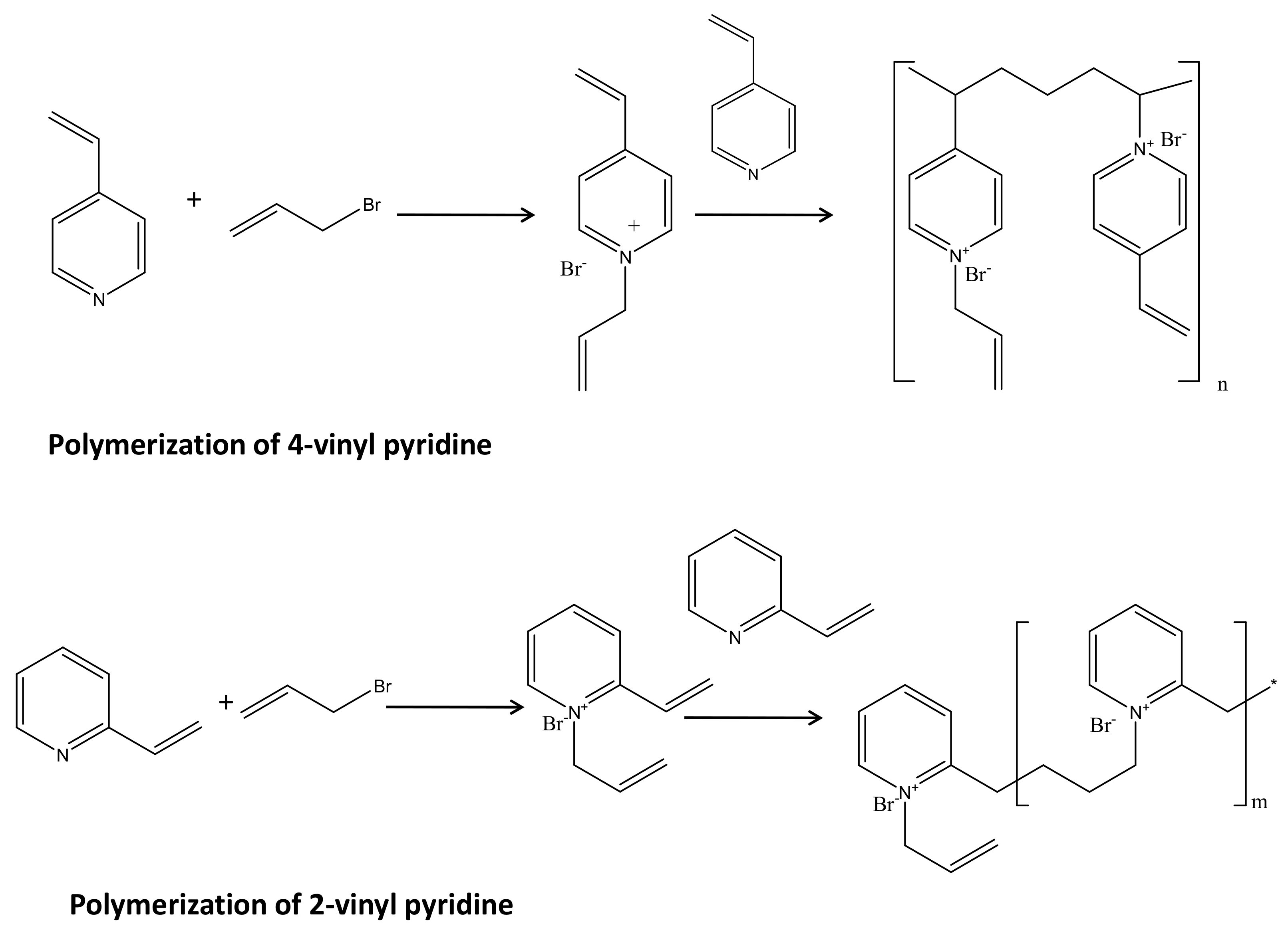
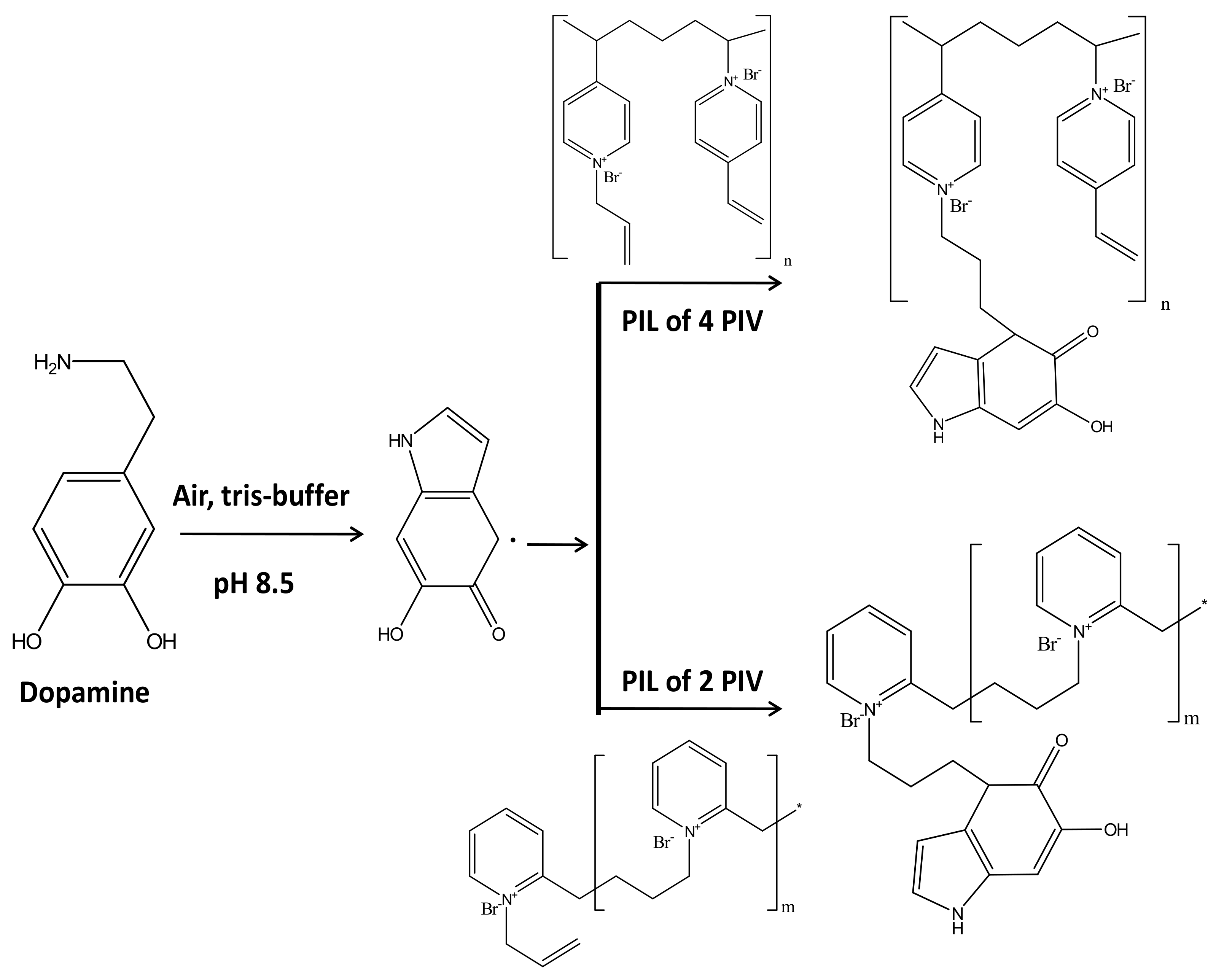
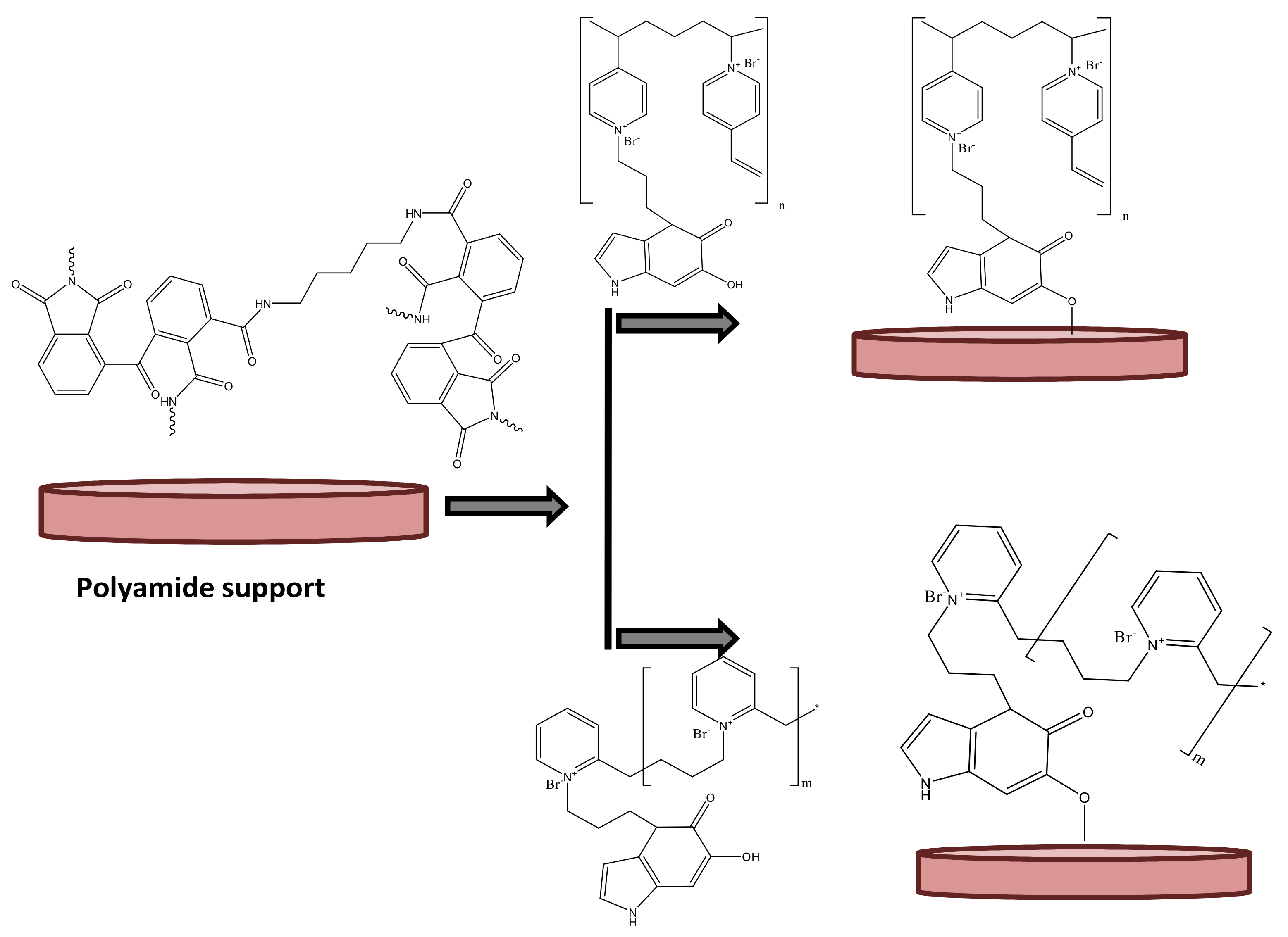

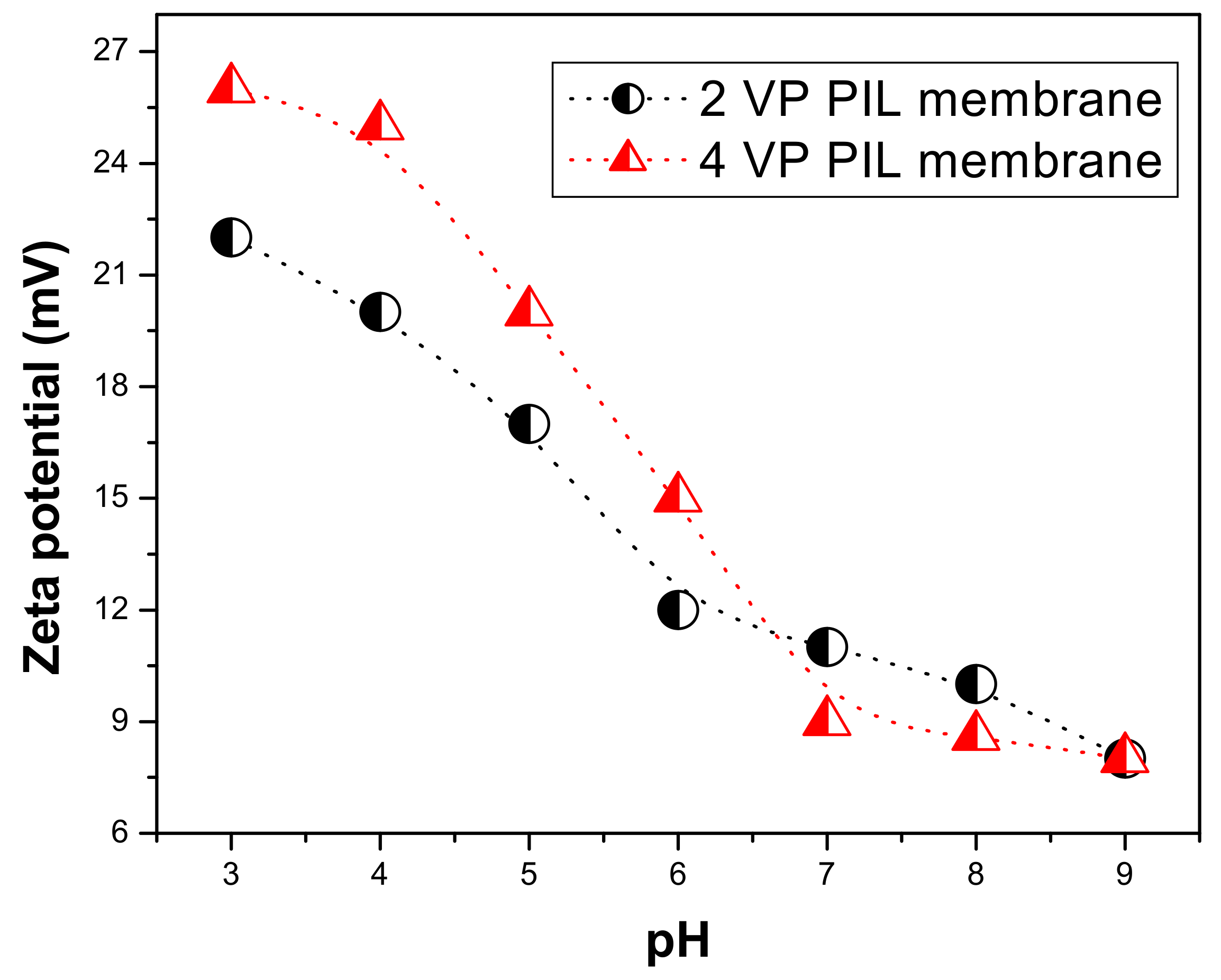
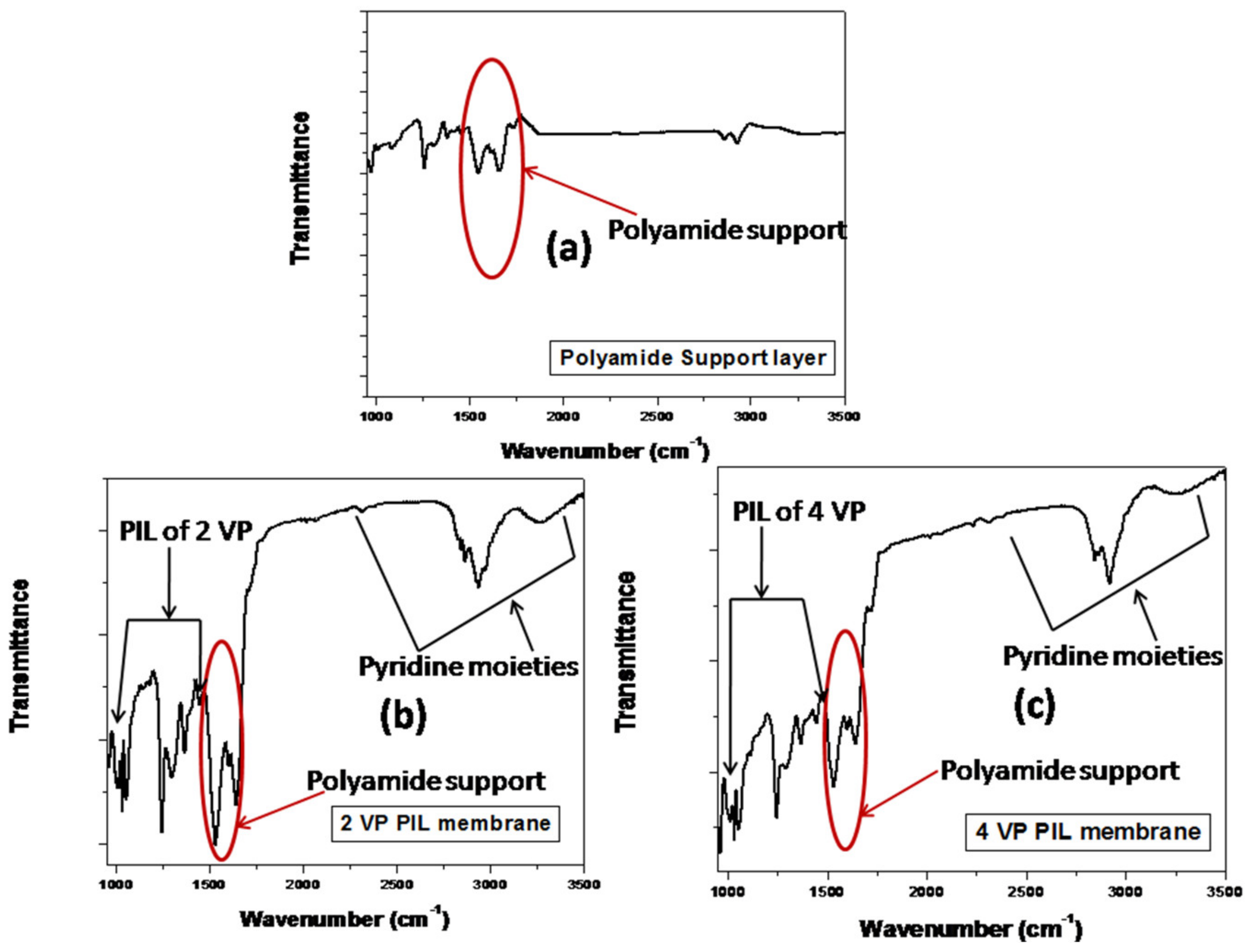
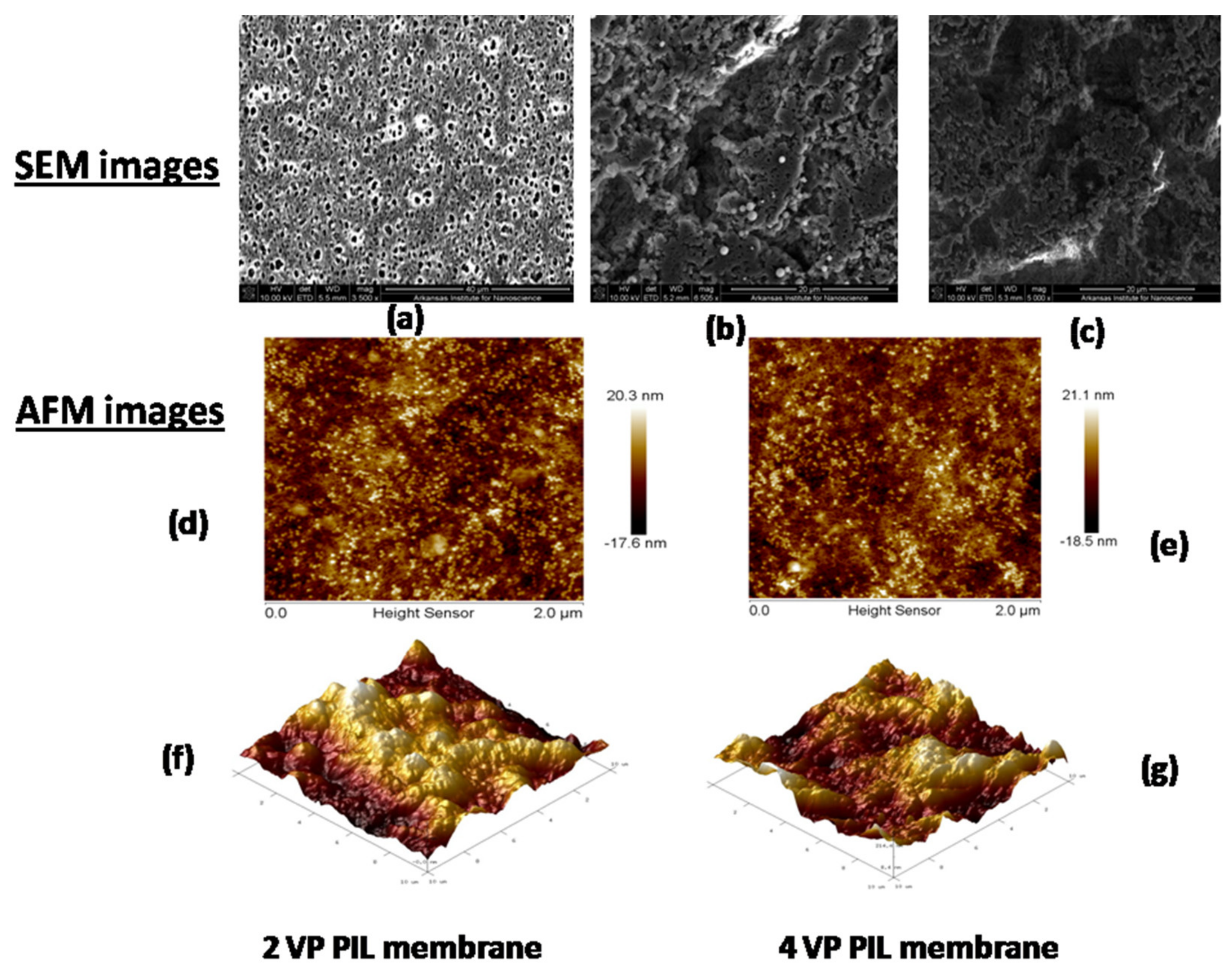
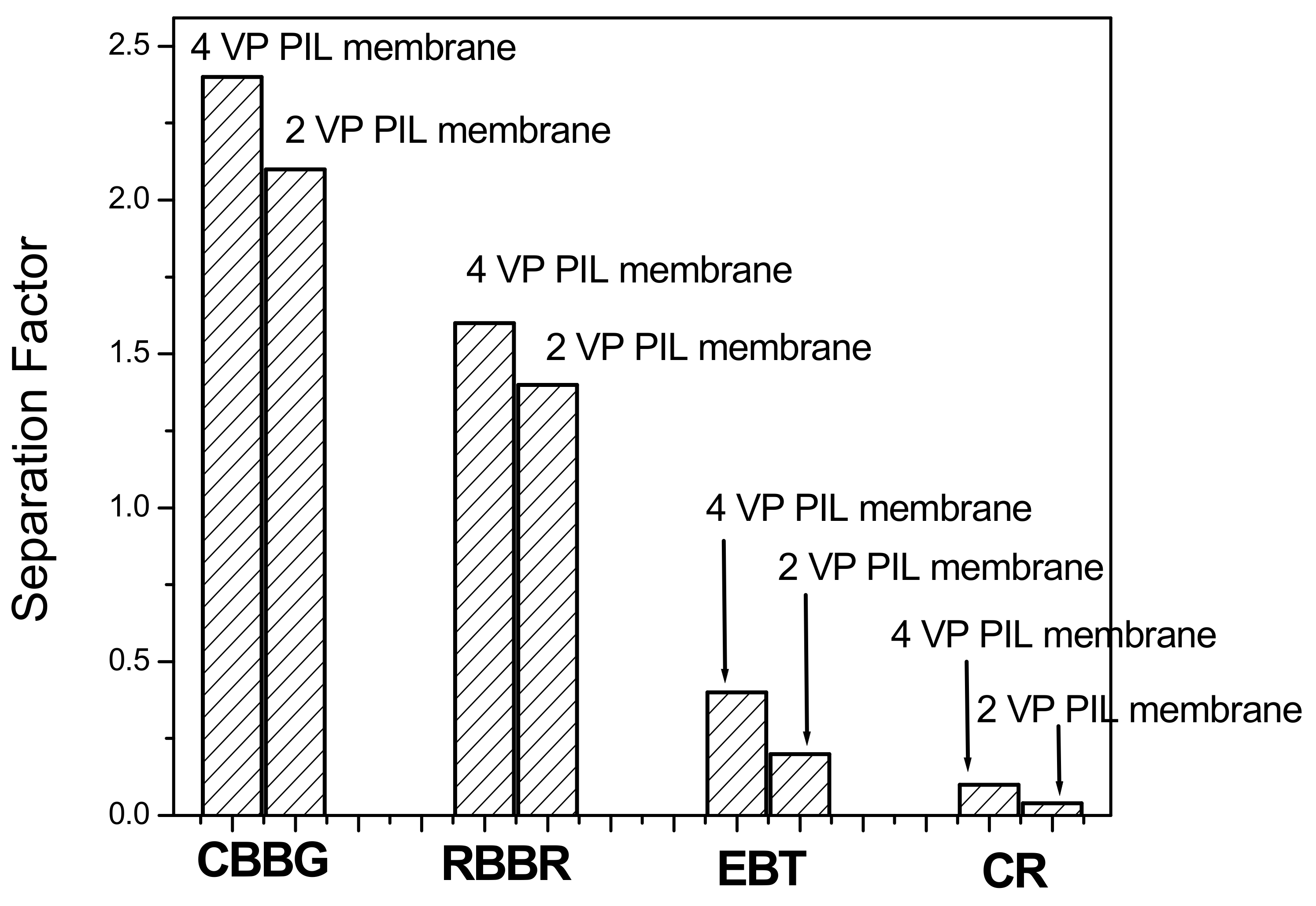

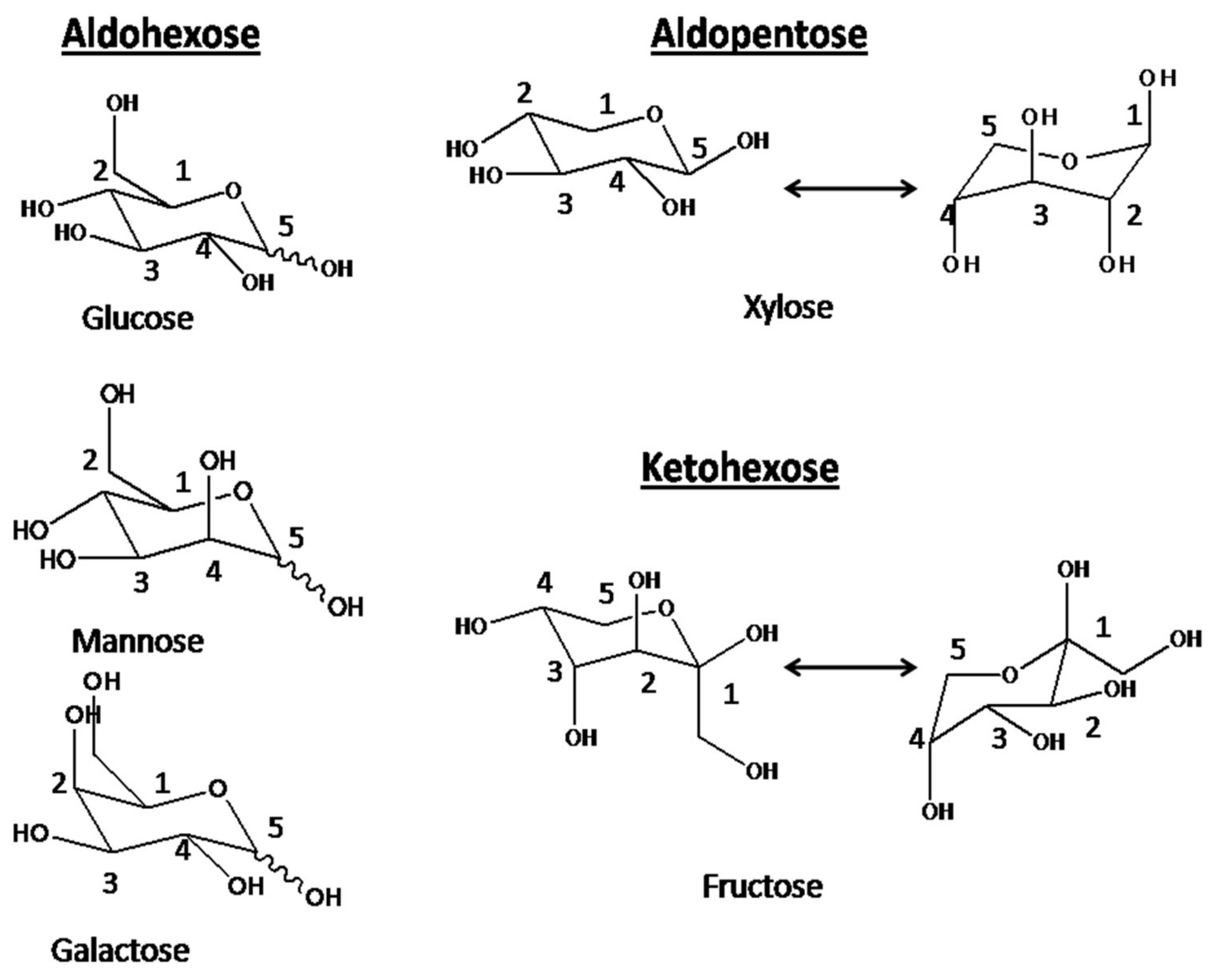
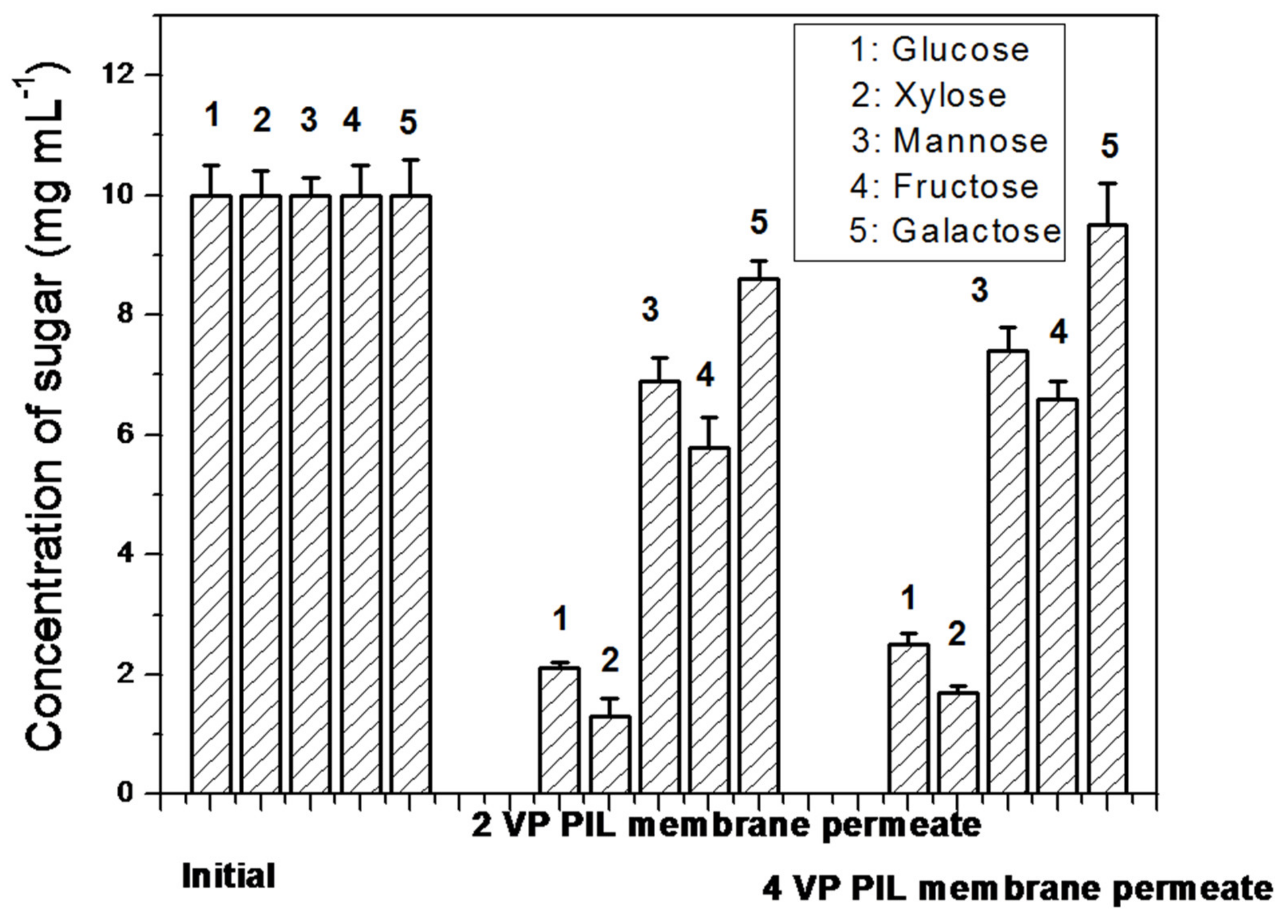
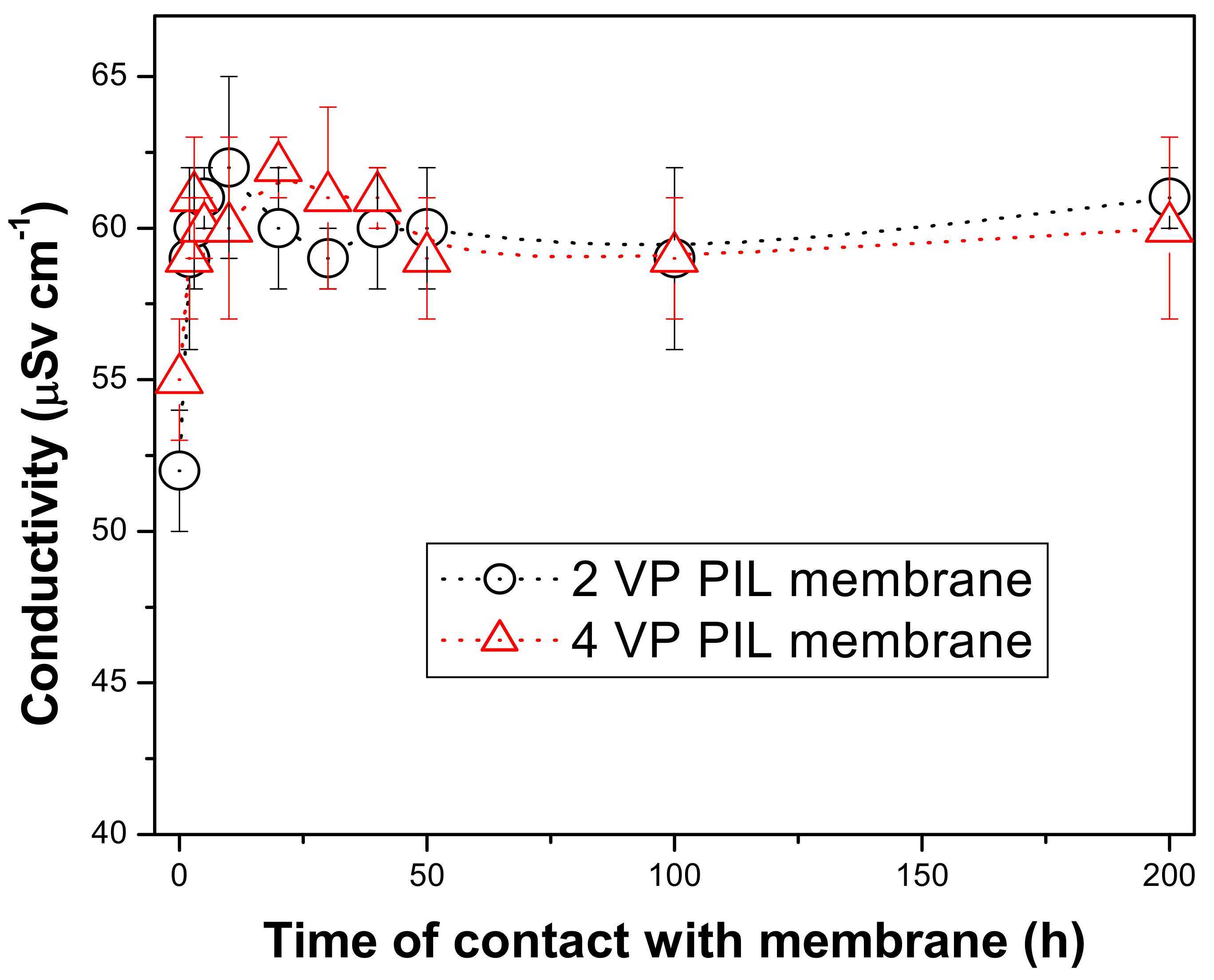
| Properties | EBT | RBBR | CR | CBBG |
|---|---|---|---|---|
| Chemical Formula | C20H12N2NaO7S | C22H16N2Na2O11S3 | C32H22N6Na2O6S2 | C47H48N3NaO7S2 |
| Molecular Weight | 461.38 g/mol | 626.53 g/mol | 696.66 g/mol | 854.05 g/mol |
| Solubility Water (g/L) | 50 | 980 | ~30 | 50 |
| Maximum Wavelength Absorbance (nm) | 503 | 592 | 490 | 467 |
| Topological Polar SA (Å2) | 173 | 255 | 233 | 153 |
| Color | Black | Dark Blue | Red-Brown | Dark Red-Blue |
| Membrane | Element | Wt.% | Error |
|---|---|---|---|
| Support layer | C | 77.07 | 11.1 |
| O | 7.83 | 3.5 | |
| N | 15.10 | 3.7 | |
| 2 VP PIL membrane | C | 49.16 | 13.2 |
| O | 3.79 | 1.7 | |
| N | 33.23 | 3.0 | |
| Br | 13.82 | 3.96 | |
| 4 VP PIL membrane | C | 55.07 | 13.2 |
| O | 4.46 | 1.2 | |
| N | 25.23 | 3.1 | |
| Br | 15.00 | 4.2 |
Publisher’s Note: MDPI stays neutral with regard to jurisdictional claims in published maps and institutional affiliations. |
© 2021 by the authors. Licensee MDPI, Basel, Switzerland. This article is an open access article distributed under the terms and conditions of the Creative Commons Attribution (CC BY) license (https://creativecommons.org/licenses/by/4.0/).
Share and Cite
DePaz, S.; Sengupta, A.; Chiao, Y.-H.; Wickramasinghe, S.R. Novel Poly(ionic liquid) Augmented Membranes for Unconventional Aqueous Phase Applications in Fractionation of Dyes and Sugar. Polymers 2021, 13, 2366. https://doi.org/10.3390/polym13142366
DePaz S, Sengupta A, Chiao Y-H, Wickramasinghe SR. Novel Poly(ionic liquid) Augmented Membranes for Unconventional Aqueous Phase Applications in Fractionation of Dyes and Sugar. Polymers. 2021; 13(14):2366. https://doi.org/10.3390/polym13142366
Chicago/Turabian StyleDePaz, Sandrina, Arijit Sengupta, Yu-Hsuan Chiao, and Sumith Ranil Wickramasinghe. 2021. "Novel Poly(ionic liquid) Augmented Membranes for Unconventional Aqueous Phase Applications in Fractionation of Dyes and Sugar" Polymers 13, no. 14: 2366. https://doi.org/10.3390/polym13142366
APA StyleDePaz, S., Sengupta, A., Chiao, Y.-H., & Wickramasinghe, S. R. (2021). Novel Poly(ionic liquid) Augmented Membranes for Unconventional Aqueous Phase Applications in Fractionation of Dyes and Sugar. Polymers, 13(14), 2366. https://doi.org/10.3390/polym13142366








